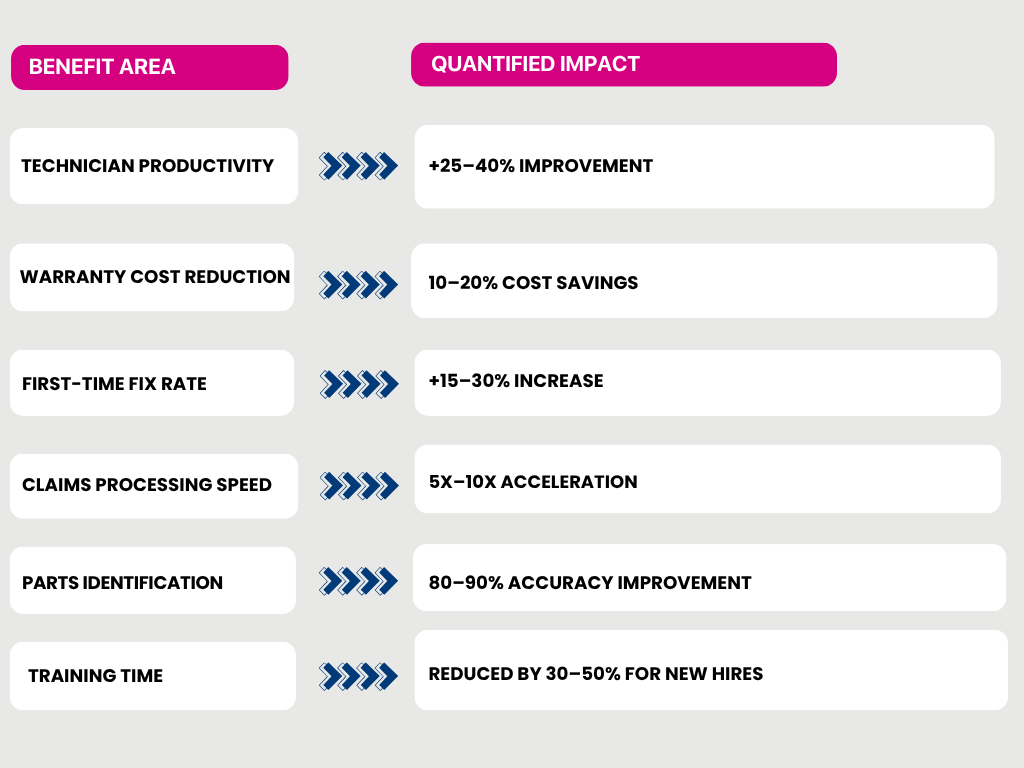Across the manufacturing and industrial sectors, field service operations, warranty processing, and parts management are under pressure. The shortage of skilled labor, increasing complexity of products, and rising customer expectations are straining traditional workforce models. Companies are struggling to hire and retain experienced technicians, claims adjusters, and parts specialists, especially those with deep technical expertise.
Service AI workers are intelligent assistants purpose-built to augment and automate decisions across service, parts, and warranty functions. These AI-powered Service advisors, analysts, and agents are transforming how manufacturers deliver service by embedding expert-level knowledge into frontline workflows.
Quick Navigation
The workforce challenge: a technical talent crisis
The scale of the skilled labor shortage in service and warranty-intensive industries is stark:
- 70% of field service organizations report a shortage of qualified technicians (Source: Field Service USA).
- 40% of current service technicians are expected to retire within the next decade, with insufficient backfill from younger generations.
- Claims backlogs have increased by up to 35% for some OEMs due to a lack of trained warranty administrators.
- Parts identification errors contribute to 10–15% of first-time fix failures, costing OEMs millions in repeat dispatches and SLA penalties.
- The average time to train a new service technician to full productivity can exceed 12 months, especially in capital equipment or industrial systems.
This technical workforce shortage threatens profitability, SLA compliance, and customer satisfaction.
What are Service AI workers?
Service AI workers are purpose-built experts, powered by AI, knowledge graphs, and decision intelligence models, that assist or automate high-skill tasks in various processes across the service lifecycle:
- Field Service: Diagnosing issues, recommending the right fix, guiding repair steps, and assisting technicians in real-time.
- Warranty: Automating eligibility checks, claim adjudication, failure analysis, and predictive insights.
- Parts: Identifying correct parts, validating compatibility, predicting demand, and recommending substitutes or bundles.

Unlike generic chatbots, these AI workers are trained on domain-specific data and augment and automate operational workflows, whether it’s a CRM, Field Service Management (FSM), or other warranty management system.
How Service AI workers address the skill gap
Service AI workers solve real industry problems:
Scaling expertise without scaling headcount
- Service AI Advisors instantly give field service technicians AI-guided diagnosis and repair instructions, reducing reliance on tribal knowledge.
Improving first-time fix rates
- AI workers recommend the right part and repair plan based on historical and real-time data.
- AI can recommend decision paths based on conditions, symptoms, and machine history.
Reducing warranty claim backlog and errors
- AI automatically checks for coverage, failure pattern recognition, and policy compliance.
- Enables real-time approval or flagging of suspicious claims with high precision.
Optimizing parts inventory and substitution
- AI-powered parts advisors recommend the right parts for the repair, ensuring technicians have what they need to complete the service job.
- Demand forecasting improves with machine learning models trained on usage patterns, service events, and connected product data.
The value of Service AI workers
When scaled across enterprise service operations, Circuitry.ai Service AI workers can unlock significant economic value:

Estimated ROI: For a mid-sized OEM with 500 technicians and $50M in warranty claims annually, implementing Service AI can yield over $10–15M in savings and efficiency gains per year.
Try our calculators today to estimate your cost savings.
Why now? Service AI can now deliver tangible results
- Workforce pressure is acute, and manufacturers can’t afford to wait years to train the next generation of experts.
- AI models are more accurate and explainable than ever before, capable of reasoning through multi-step decisions.
- System integration is easier, with APIs allowing AI workers to plug into FSM, CRM, WMS, and other warranty platforms.
Service AI workers aren’t replacing human expertise; they’re amplifying, preserving, and instantly making it accessible to anyone in the field or back office. They offer a practical and high-ROI path to overcome labor shortages, increase service quality, and deliver on customer expectations without burning out your team.
For manufacturers navigating today’s complex service landscape, Service AI isn’t a future vision; it’s a workforce multiplier available now.
Want to see how Service AI Workers can transform your service operations? Contact us for a demo, free impact assessment, or pilot opportunity.
